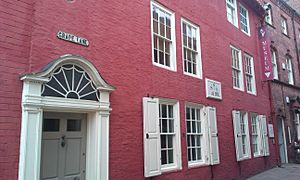Captain Cook Memorial Museum facts for kids

Captain Walker's House
|
|
| Lua error in Module:Location_map at line 420: attempt to index field 'wikibase' (a nil value). | |
| Established | 1986 |
|---|---|
| Location | Whitby, North Yorkshire |
| Type | Maritime Museum |
| Public transit access | Bus/Railway Stations |
|
Listed Building – Grade I
|
|
| Designated | 23 February 1954 |
| Reference no. | 1148246 |
The Captain Cook Memorial Museum is a history museum located in Whitby, North Yorkshire, England. It is set in a special building called Walker's House. This house once belonged to Captain John Walker, who was a very important person in the life of the famous explorer James Cook. Cook actually lived here as a young apprentice in 1746. He even came back to visit his old master in the winter of 1771–72, after his first big voyage around the world.
Contents
The Historic House
The museum building is on Grape Lane, right by the harbour. A sign on the wall tells us that Moses and Susannah Dring built the house in 1688. It is a large building with three main floors and an attic. It's a great example of what a wealthy ship-owner's home looked like back then.
We know a lot about how the house was furnished because of a detailed list made in 1754. The two rooms on the ground floor are decorated and furnished just like they were, using the original colours and items from that list.
Captain Cook's Connection
Captain John Walker's father bought this house in 1729. It became the family home and their business office. Captain John Walker followed in his father's footsteps, becoming a merchant captain and growing the family's shipping business.
In 1746, James Cook was introduced to Captain John Walker. Cook had been working for a grocer in a nearby fishing village called Staithes. Captain Walker hired Cook as an apprentice sailor for three years. Cook worked for Walker first as an apprentice, then as a regular sailor, and finally as a master's mate. He stayed with Walker until he joined the Royal Navy in 1755.
Most of Cook's time with Walker was spent at sea on ships that carried coal. These ships mainly sailed between the River Tyne and London. However, Cook also made voyages to the Baltic Sea and Dublin.
Cook's Studies in the Attic
A historian named George Young wrote about Cook's life in 1836. He said that Captain Walker sometimes kept Cook in Whitby during his apprenticeship. Cook would stay in the attic of the house on Grape Lane. This story makes sense because ship owners often let apprentices go home in winter. But if an apprentice stayed, they would be boarded somewhere convenient, like the Grape Lane house.
Young also wrote that Cook studied in the attic by candlelight. A family servant, Mary Prowd, would provide the candles. Like many ambitious apprentices, Cook would have studied important subjects. These included algebra, geometry, trigonometry, and navigation. Ship owners likely paid for teachers to help their apprentices learn these skills.
A Special Visit
The house was also the place where Cook made his only known visit to Whitby after 1755. This happened in the winter of 1771–72. Cook was staying in Great Ayton and rode his horse to visit his old master in Whitby.
When Cook arrived, the whole household lined up to greet him. They were told to be on their best behaviour. But the elderly housekeeper, Mary Prowd, who had been kind to Cook many years before, could not hold back her excitement. She hugged him and cried, "Oh honey James! How glad I is to see thee!"
What Archaeology Revealed
In 2001, archaeologists studied the area around the house. Their investigations uncovered some interesting things:
- They found the foundations of small buildings. These were likely outbuildings used for the Walkers' shipping business.
- They discovered a brick floor with a herringbone pattern next to the house. It was about a metre below the current ground level. A "brick-floored room," which was a kitchen, was mentioned in the 1754 inventory. Its exact location was unknown until this discovery.
- They also found a slipway that led from the main building down to the river. Deposits found above it dated from the mid-to-late 1700s. The courtyard, which is now above the slipway, was built over it later. This happened as the Walker family moved from shipping into banking and insurance.
The Museum Today
The Cook Museum Trust bought Walker's House to create a museum in Whitby. This museum celebrates the life of Captain Cook and the people who sailed with him. This includes the scientists, artists, and crews on his voyages.
The museum's collections include:
- Original letters about Cook's voyages. These include letters from Cook himself, Lord Sandwich, Sir Joseph Banks, and the Forsters.
- Paintings and drawings by artists who traveled with Cook to the Pacific. These artists include Sydney Parkinson, William Hodges, and John Webber.
- Artefacts from the Pacific islands and New Zealand.
- Original maps and charts.
- Models of ships.
In 2009, the museum bought a painting called Matavai Bay Otaheite by William Hodges. This painting, from the 1770s, shows Matavai Bay in Tahiti. Cook visited this bay on his second voyage. Several charities and trusts, including The Art Fund, helped the museum buy this important artwork.
The museum has received awards for its excellence. Welcome to Yorkshire gave it a White Rose Award in 2005 and 2012. It also won a VisitEngland Gold Award for Excellence in 2013.

